Abstract
The effects of Fab fragments of high-affinity specific antibodies have been studied in a canine experimental model of lethal digitoxin toxicity. Selected antiserum from sheep immunized and boosted with a digoxin-serum albumin conjugate contained antibodies that cross-reacted with digitoxin with an average intrinsic association constant of 1.4 × 1010 M−1 as determined by equilibrium dialysis. Rapid second-order association kinetics (kf = 3.7 × 106 M−1 per s) and slow dissociation kinetics (kr = 1.9 × 10−4 per s) were documented for the antibody-digitoxin complex. Eight dogs given 0.5 mg/kg digitoxin intravenously developed ventricular tachycardia after 23±4 (SEM) min. Control nonspecific Fab fragments were then given. All animals died an average of 101±36 min after digitoxin administration. Another eight dogs given the same digitoxin dose similarly developed ventricular tachycardia after 28±3 min. This group then received a molar equivalent dose of specific Fab fragments intravenously over 3 min, followed by a 30-min infusion of one-third of the initial dose. All dogs survived. Conducted sinus beats reappeared 18±4 min after initial Fab infusion, and stable normal sinus rhythm was present at 54±16 min. Plasma total digitoxin concentrations increased threefold during the hour after initial Fab infusion, while plasma free digitoxin concentration decreased to less than 0.1 ng/ml. Effects on digitoxin pharmacokinetics of these Fab fragments and the antibody population from which they were derived were further investigated in a primate species. Unlike common laboratory animals previously studied, the rhesus monkey was found to have a prolonged elimination half-life, estimated at 135 and 118 h by radioimmunoassay and [3H]digitoxin measurements, respectively, similar to man and thus providing a clinically relevant experimental model. Intravenous administration of 2 mol of specific Fab fragments per mole of digitoxin 6 h after 0.2 mg of digitoxin produced a rapid 4.3-fold increase in plasma total digitoxin concentration followed by a rapid fall (t½ 4 h) accompanied by a 14-fold enhancement of urinary digitoxin excretion over control values during the 6-h period after Fab was given. Analytical studies were consistent with increased excretion of native digitoxin rather than metabolites, and the glycoside was found in equilibrium dialysis studies to be excreted in the urine in Fab-bound form. Administration of 2 mol of specific antibody binding sites per mole of digitoxin as intact IgG caused a greater and more prolonged increase in plasma total digitoxin concentration, peaking 13-fold above control levels. In contrast to the effects of Fab, however, specific IgG reduced the rate of urinary digitoxin excretion substantially below control values. We conclude that Fab fragments of antibodies with high affinity for digitoxin are capable of rapid reversal of advanced, otherwise lethal digitoxin toxicity, and are capable of reducing the plasma half-life and accelerating urinary excretion of digitoxin.
Full text
PDF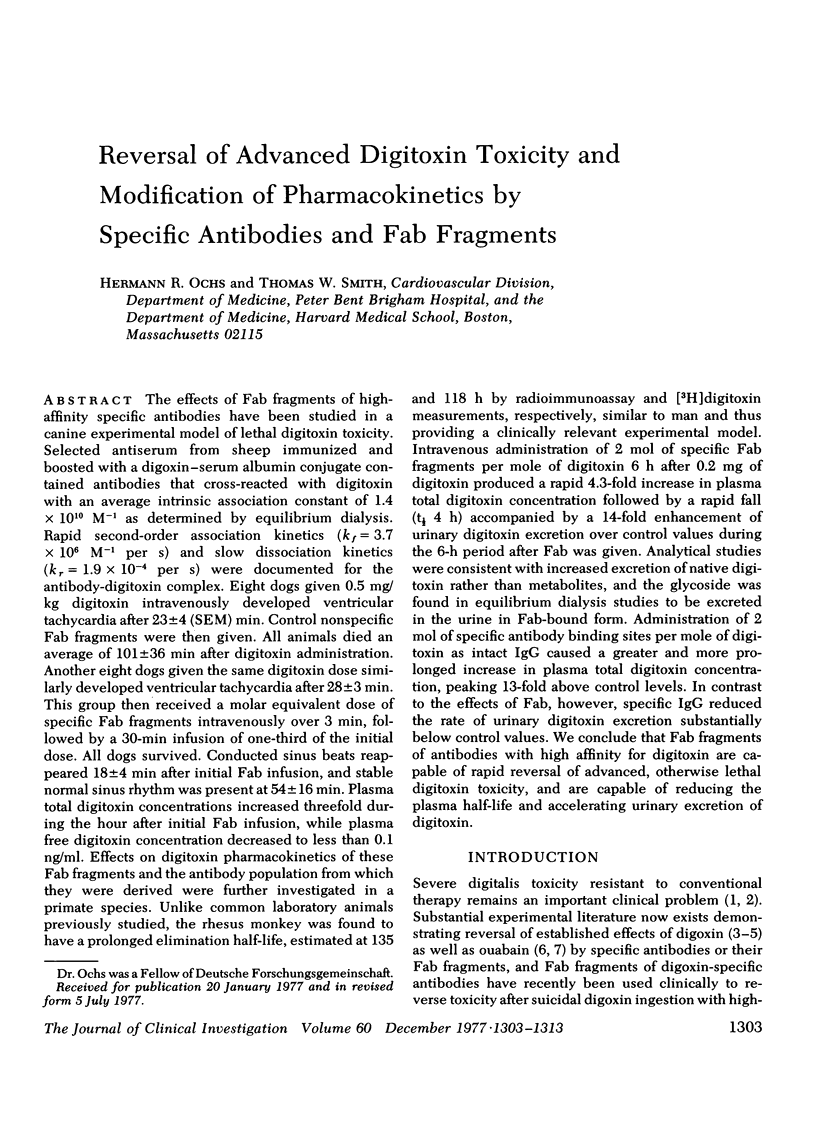
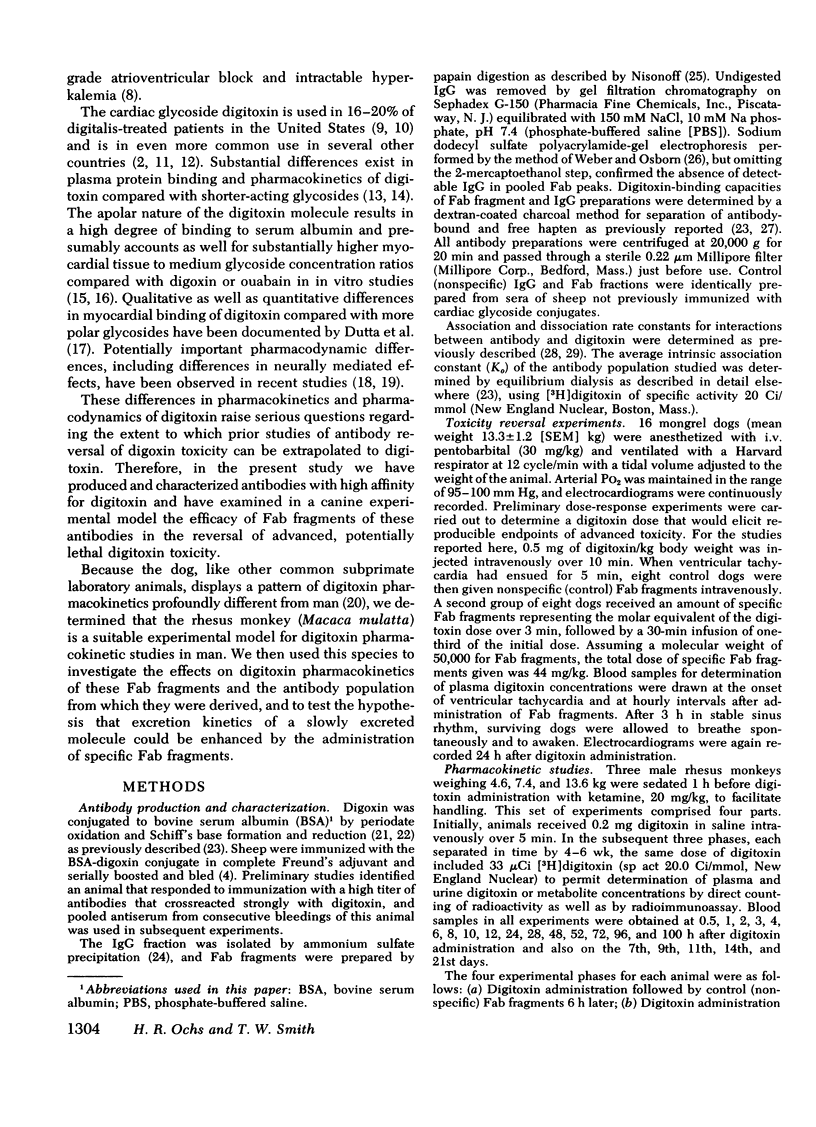


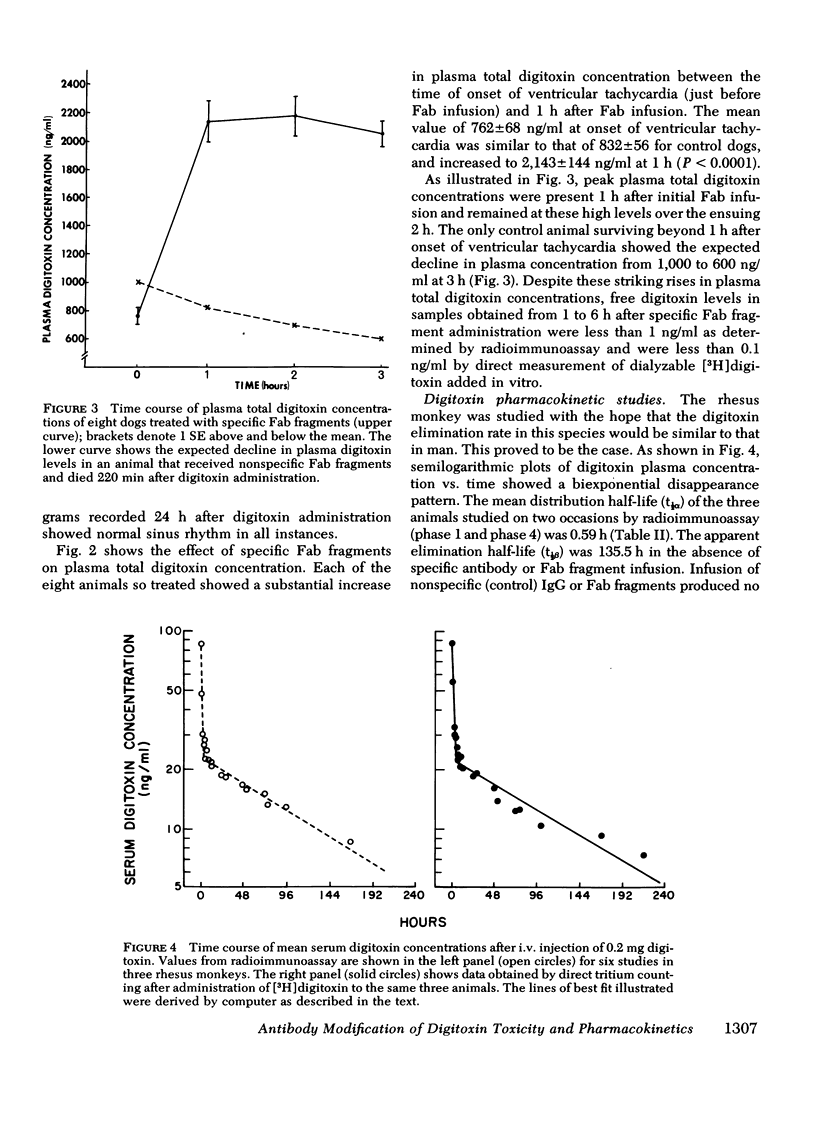
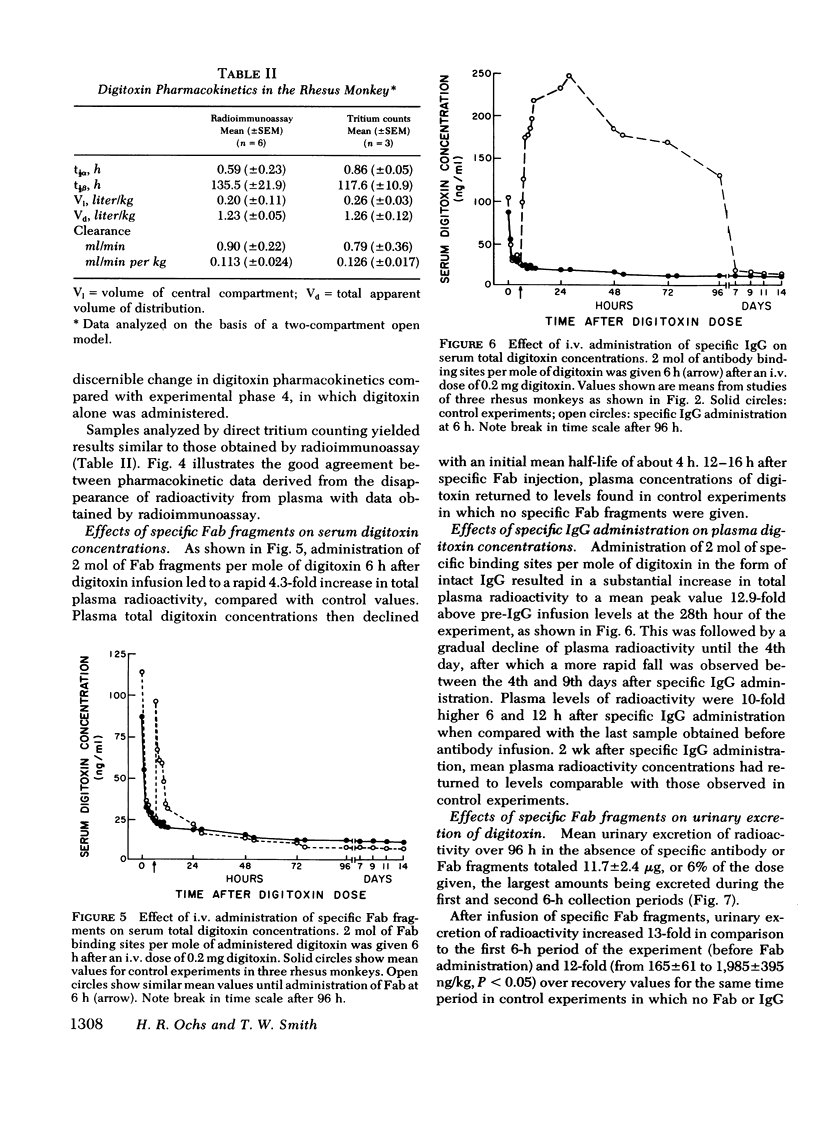

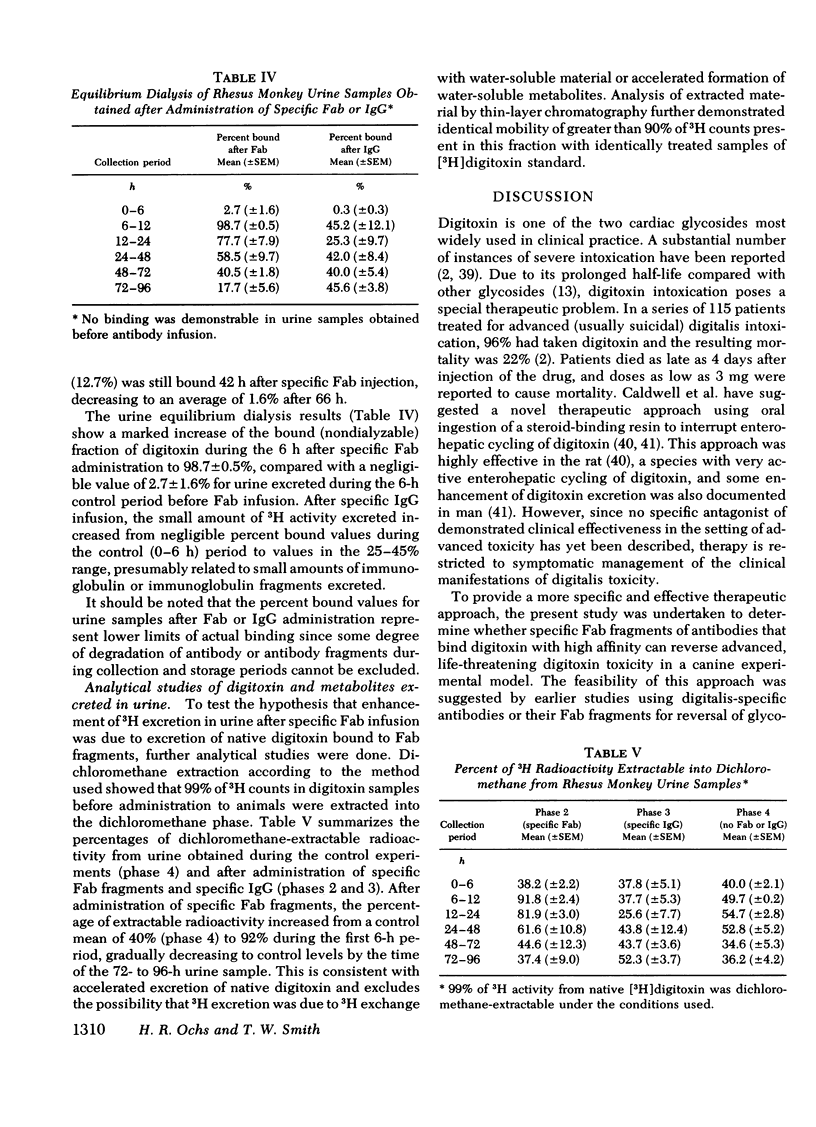
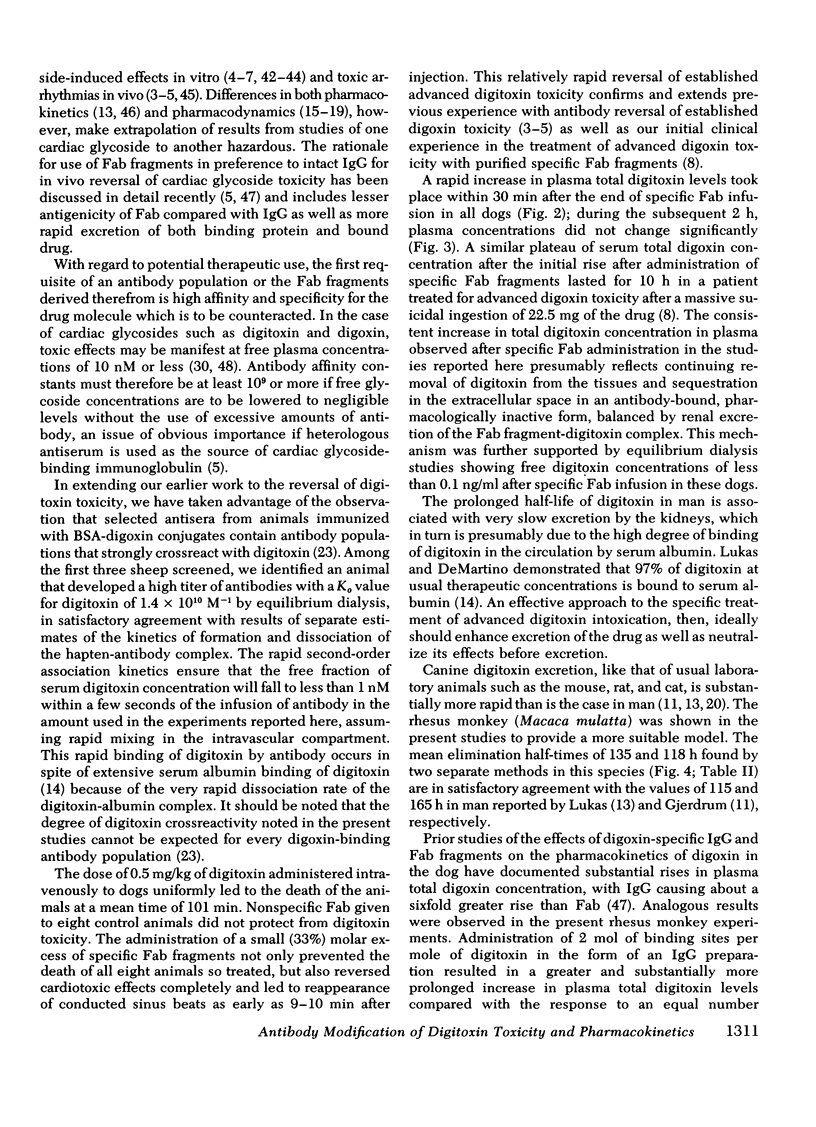
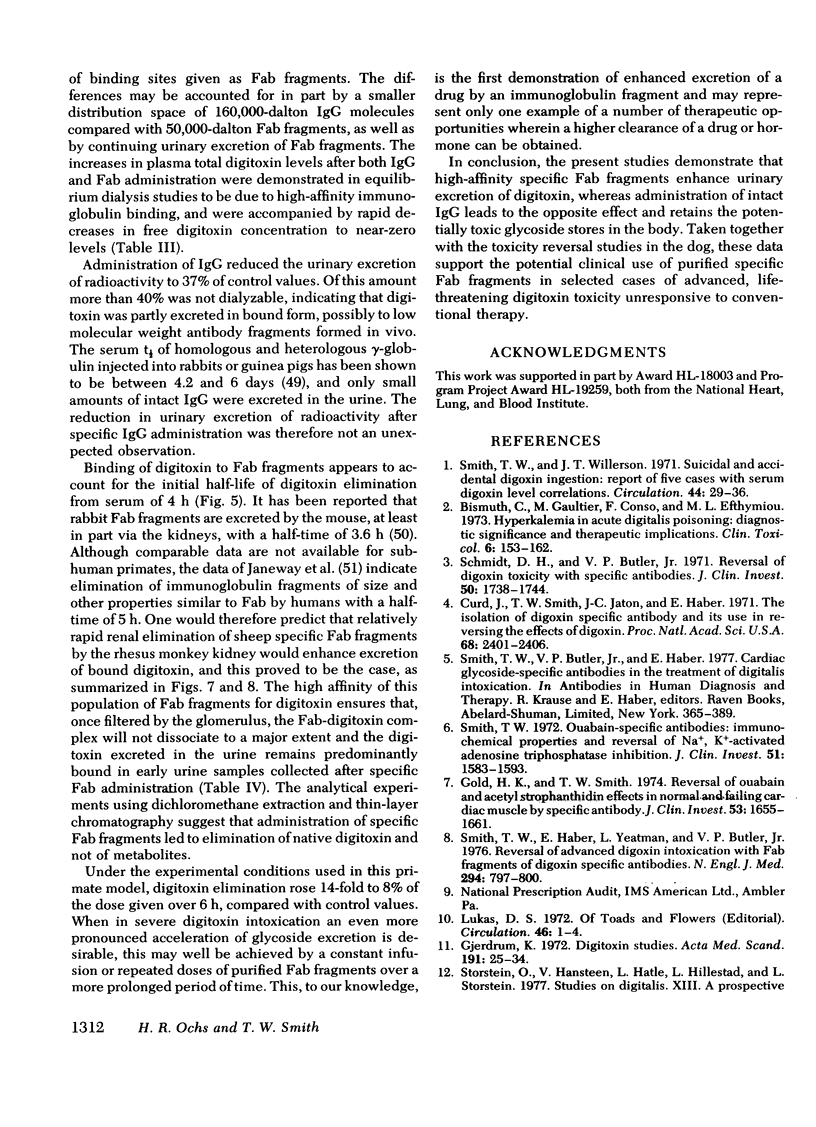
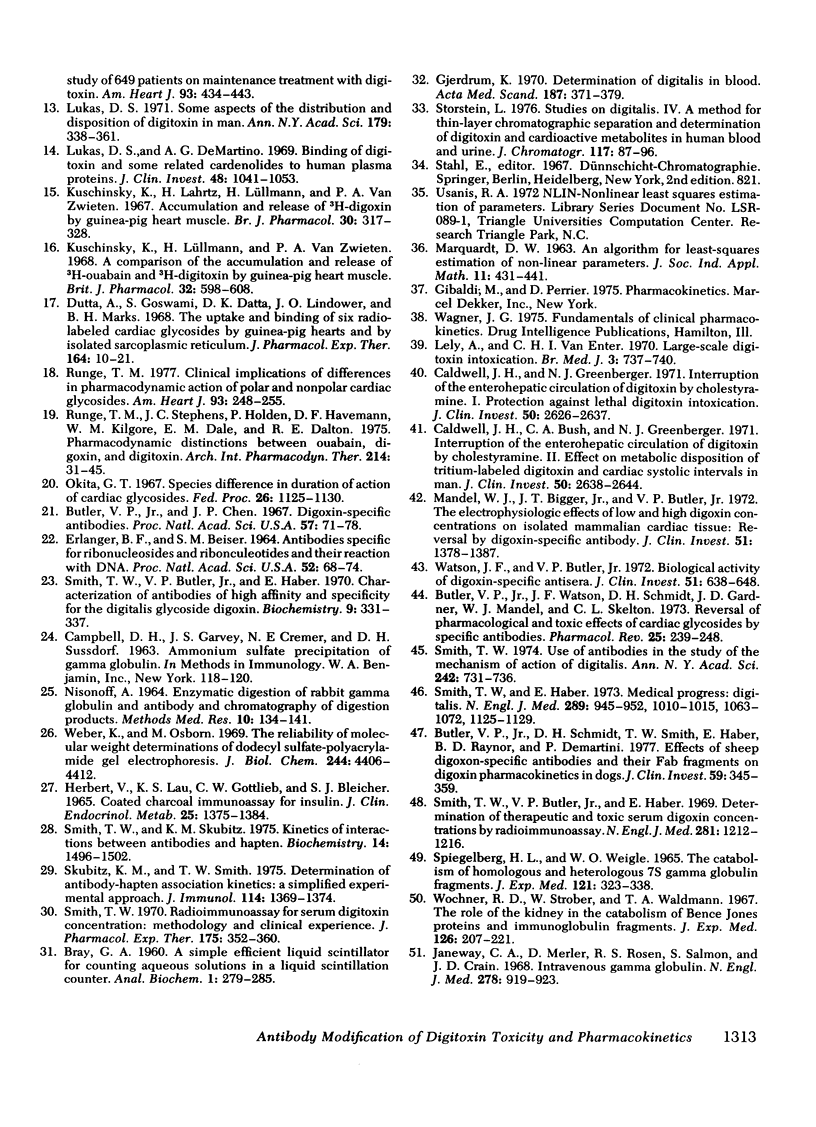
Selected References
These references are in PubMed. This may not be the complete list of references from this article.
- Bismuth C., Gaultier M., Conso F., Efthymiou M. L. Hyperkalemia in acute digitalis poisoning: prognostic significance and therapeutic implications. Clin Toxicol. 1973;6(2):153–162. doi: 10.3109/15563657308990513. [DOI] [PubMed] [Google Scholar]
- Butler V. P., Jr, Chen J. P. Digoxin-specific antibodies. Proc Natl Acad Sci U S A. 1967 Jan;57(1):71–78. doi: 10.1073/pnas.57.1.71. [DOI] [PMC free article] [PubMed] [Google Scholar]
- Butler V. P., Jr, Schmidt D. H., Smith T. W., Haber E., Raynor B. D., Demartini P. Effects of sheep digoxin-specific antibodies and their Fab fragments on digoxin pharmacokinetics in dogs. J Clin Invest. 1977 Feb;59(2):345–359. doi: 10.1172/JCI108647. [DOI] [PMC free article] [PubMed] [Google Scholar]
- Butler V. P., Jr, Watson J. F., Schmidt D. H., Gardner J. D., Mandel W. J., Skelton C. L. Reversal of the pharmacological and toxic effects of cardiac glycosides by specific antibodies. Pharmacol Rev. 1973 Jun;25(2):239–248. [PubMed] [Google Scholar]
- Caldwell J. H., Bush C. A., Greenberger N. J. Interruption of the enterohepatic circulation of digitoxin by cholestyramine. II. Effect on metabolic disposition of tritium-labeled digitoxin and cardiac systolic intervals in man. J Clin Invest. 1971 Dec;50(12):2638–2644. doi: 10.1172/JCI106764. [DOI] [PMC free article] [PubMed] [Google Scholar]
- Caldwell J. H., Greenberger N. J. Interruption of the enterohepatic circulation of digitoxin by cholestyramine. I. Protection against lethal digitoxin intoxication. J Clin Invest. 1971 Dec;50(12):2626–2637. doi: 10.1172/JCI106763. [DOI] [PMC free article] [PubMed] [Google Scholar]
- Curd J., Smith T. W., Jaton J. C., Haber E. The isolation of digoxin-specific antibody and its use in reversing the effects of digoxin. Proc Natl Acad Sci U S A. 1971 Oct;68(10):2401–2406. doi: 10.1073/pnas.68.10.2401. [DOI] [PMC free article] [PubMed] [Google Scholar]
- Dutta S., Goswami S., Datta D. K., Lindower J. O., Marks B. H. The uptake and binding of six radiolabeled cardiac glycosides by guinea-pig hearts and by isolated sarcoplasmic reticulum. J Pharmacol Exp Ther. 1968 Nov;164(1):10–21. [PubMed] [Google Scholar]
- ERLANGER B. F., BEISER S. M. ANTIBODIES SPECIFIC FOR RIBONUCLEOSIDES AND RIBONUCLEOTIDES AND THEIR REACTION WITH DNA. Proc Natl Acad Sci U S A. 1964 Jul;52:68–74. doi: 10.1073/pnas.52.1.68. [DOI] [PMC free article] [PubMed] [Google Scholar]
- Gjerdrum K. Determination of digitalis in blood. Acta Med Scand. 1970 May;187(5):371–379. doi: 10.1111/j.0954-6820.1970.tb02958.x. [DOI] [PubMed] [Google Scholar]
- Gjerdrum K. Digitoxin studies. Serum concentration during digitalization, maintenance therapy and withdrawal. Estimation of proper maintenance dose. Acta Med Scand. 1972 Jan-Feb;191(1-2):25–34. [PubMed] [Google Scholar]
- Gold H. K., Smith T. W. Reversal of ouabain and acetyl strophanthidin effects in normal and failing cardiac muscle by specific antibody. J Clin Invest. 1974 Jun;53(6):1655–1661. doi: 10.1172/JCI107716. [DOI] [PMC free article] [PubMed] [Google Scholar]
- Herbert V., Lau K. S., Gottlieb C. W., Bleicher S. J. Coated charcoal immunoassay of insulin. J Clin Endocrinol Metab. 1965 Oct;25(10):1375–1384. doi: 10.1210/jcem-25-10-1375. [DOI] [PubMed] [Google Scholar]
- Janeway C. A., Merler E., Rosen F. S., Salmon S., Crain J. D. Metabolism of gamma globulin fragments in normal and agammaglobulinemic persons. N Engl J Med. 1968 Apr 25;278(17):919–923. doi: 10.1056/NEJM196804252781701. [DOI] [PubMed] [Google Scholar]
- Kuschinsky K., Lahrtz H., Lüllmann H., van Zwieten P. A. Accumulation and release of 3H-digoxin by guinea-pig heart muscle. Br J Pharmacol Chemother. 1967 Jun;30(2):317–328. doi: 10.1111/j.1476-5381.1967.tb02138.x. [DOI] [PMC free article] [PubMed] [Google Scholar]
- Kuschinsky K., Lüllmann H., van Zwieten P. A. A comparison of the accumulation and release of 3H-ouabain and 3H-digitoxin by guinea-pig heart muscle. Br J Pharmacol Chemother. 1968 Mar;32(3):598–608. doi: 10.1111/j.1476-5381.1968.tb00460.x. [DOI] [PMC free article] [PubMed] [Google Scholar]
- Lely A. H., van Enter C. H. Large-scale digitoxin intoxication. Br Med J. 1970 Sep 26;3(5725):737–740. doi: 10.1136/bmj.3.5725.737. [DOI] [PMC free article] [PubMed] [Google Scholar]
- Lukas D. S., De Martino A. G. Binding of digitoxin and some related cardenolides to human plasma proteins. J Clin Invest. 1969 Jun;48(6):1041–1053. doi: 10.1172/JCI106060. [DOI] [PMC free article] [PubMed] [Google Scholar]
- Lukas D. S. Of toads and flowers. Circulation. 1972 Jul;46(1):1–4. doi: 10.1161/01.cir.46.1.1. [DOI] [PubMed] [Google Scholar]
- Lukas D. S. Some aspects of the distribution and disposition of digitoxin in man. Ann N Y Acad Sci. 1971 Jul 6;179:338–361. doi: 10.1111/j.1749-6632.1971.tb46912.x. [DOI] [PubMed] [Google Scholar]
- Mandel W. J., Bigger J. T., Jr, Butler V. P., Jr The electrophysiologic effects of low and high digoxin concentrations on isolated mammalian cardiac tissue: reversal by digoxin-specific antibody. J Clin Invest. 1972 Jun;51(6):1378–1387. doi: 10.1172/JCI106933. [DOI] [PMC free article] [PubMed] [Google Scholar]
- NISONOFF A. ENZYMATIC DIGESTION OF RABBIT GAMMA GLOBULIN AND ANTIBODY AND CHROMATOGRAPHY OF DIGESTION PRODUCTS. Methods Med Res. 1964;10:134–141. [PubMed] [Google Scholar]
- Okita G. T. Species difference in duration of action of cardiac glycosides. Fed Proc. 1967 Jul-Aug;26(4):1125–1130. [PubMed] [Google Scholar]
- Runge T. M. Clinical implications of differences in pharmacodynamic action of polar and nonpolar cardiac glycosides. Am Heart J. 1977 Feb;93(2):248–255. doi: 10.1016/s0002-8703(77)80319-0. [DOI] [PubMed] [Google Scholar]
- Runge T. M., Stephens J. C., Holden P., Havemann D. F., Kilgore W. M., Dale E. M., Dalton R. E. Pharmacodynamic distinctions between ouabain, digoxin and digitoxin. Arch Int Pharmacodyn Ther. 1975 Mar;214(1):31–45. [PubMed] [Google Scholar]
- SPIEGELBERG H. L., WEIGLE W. O. THE CATABOLISM OF HOMOLOGOUS AND HETEROLOGOUS 7S GAMMA GLOBULIN FRAGMENTS. J Exp Med. 1965 Mar 1;121:323–338. doi: 10.1084/jem.121.3.323. [DOI] [PMC free article] [PubMed] [Google Scholar]
- Schmidt D. H., Butler V. P., Jr Reversal of digoxin toxicity with specific antibodies. J Clin Invest. 1971 Aug;50(8):1738–1744. doi: 10.1172/JCI106663. [DOI] [PMC free article] [PubMed] [Google Scholar]
- Skubitz K. M., Smith T. W. Determination of antibody-hapten association kinetics: a simplified experimental approach. J Immunol. 1975 Apr;114(4):1369–1374. [PubMed] [Google Scholar]
- Smith T. W., Butler V. P., Jr, Haber E. Characterization of antibodies of high affinity and specificity for the digitalis glycoside digoxin. Biochemistry. 1970 Jan 20;9(2):331–337. doi: 10.1021/bi00804a020. [DOI] [PubMed] [Google Scholar]
- Smith T. W., Butler V. P., Jr, Haber E. Determination of therapeutic and toxic serum digoxin concentrations by radioimmunoassay. N Engl J Med. 1969 Nov 27;281(22):1212–1216. doi: 10.1056/NEJM196911272812203. [DOI] [PubMed] [Google Scholar]
- Smith T. W., Haber E. Digitalis (second of four parts). N Engl J Med. 1973 Nov 8;289(19):1010–1015. doi: 10.1056/NEJM197311082891905. [DOI] [PubMed] [Google Scholar]
- Smith T. W., Haber E., Yeatman L., Butler V. P., Jr Reversal of advanced digoxin intoxication with Fab fragments of digoxin-specific antibodies. N Engl J Med. 1976 Apr 8;294(15):797–800. doi: 10.1056/NEJM197604082941501. [DOI] [PubMed] [Google Scholar]
- Smith T. W. Ouabain-specific antibodies: immunochemical properties and reversal of Na + , K + -activated adenosine triphosphatase inhibition. J Clin Invest. 1972 Jun;51(6):1583–1593. doi: 10.1172/JCI106956. [DOI] [PMC free article] [PubMed] [Google Scholar]
- Smith T. W. Radioimmunoassay for serum digitoxin concentration: methodology and clinical experience. J Pharmacol Exp Ther. 1970 Nov;175(2):352–360. [PubMed] [Google Scholar]
- Smith T. W., Skubitz K. M. Kinetics in interactions between antibodies and haptens. Biochemistry. 1975 Apr 8;14(7):1496–1502. doi: 10.1021/bi00678a023. [DOI] [PubMed] [Google Scholar]
- Smith T. W. Use of antibodies in the study of the mechanism of action of digitalis. Ann N Y Acad Sci. 1974;242(0):731–765. doi: 10.1111/j.1749-6632.1974.tb19134.x. [DOI] [PubMed] [Google Scholar]
- Smith T. W., Willerson J. T. Suicidal and accidental digoxin ingestion. Report of five cases with serum digoxin level correlations. Circulation. 1971 Jul;44(1):29–36. doi: 10.1161/01.cir.44.1.29. [DOI] [PubMed] [Google Scholar]
- Storstein L. Studies on digitalis. IV. A method for thin-layer chromatographic separation and determination of digitoxin and cardioactive metabolites in human blood and urine. J Chromatogr. 1976 Feb 4;117(1):87–96. doi: 10.1016/s0021-9673(00)81069-9. [DOI] [PubMed] [Google Scholar]
- Storstein O., Hansteen V., Hatle L., Hillestad L., Storstein L. Studies on digitalis. XIII. A prospective study of 649 patients on maintenance treatment with digitoxin. Am Heart J. 1977 Apr;93(4):434–443. doi: 10.1016/s0002-8703(77)80405-5. [DOI] [PubMed] [Google Scholar]
- Watson J. F., Butler V. P., Jr Biologic activity of digoxin-specific antisera. J Clin Invest. 1972 Mar;51(3):638–648. doi: 10.1172/JCI106853. [DOI] [PMC free article] [PubMed] [Google Scholar]
- Weber K., Osborn M. The reliability of molecular weight determinations by dodecyl sulfate-polyacrylamide gel electrophoresis. J Biol Chem. 1969 Aug 25;244(16):4406–4412. [PubMed] [Google Scholar]
- Wochner R. D., Strober W., Waldmann T. A. The role of the kidney in the catabolism of Bence Jones proteins and immunoglobulin fragments. J Exp Med. 1967 Aug 1;126(2):207–221. doi: 10.1084/jem.126.2.207. [DOI] [PMC free article] [PubMed] [Google Scholar]


